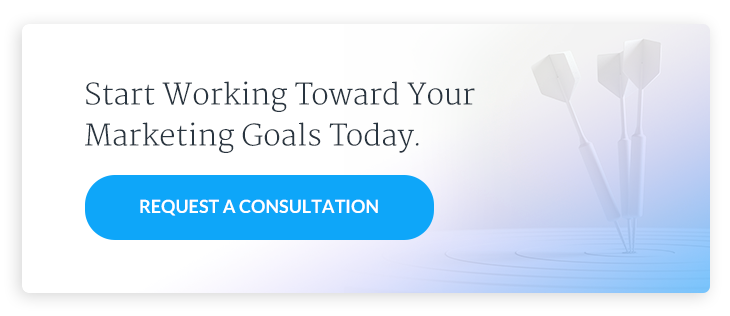
5 Marketing Strategies That Aren't What They Used to Be

Over the past few years – and even months – inbound content marketing strategies have changed at a velocity that is reminiscent of being on a rollercoaster in the dark, leaving marketing teams feeling unsure of the way forward. What is the best way to increase brand awareness and attract qualified leads? Those answers can differ greatly from strategies you used just a couple of years ago.
It can be easy to react to the economic climate by slashing your marketing budget, but this short-term solution may have disastrous results over the long term. Because of these changes, such as the increased capabilities and potential of AI, you need strong content and a stronger marketing team more than ever.
Outdated Inbound Content Marketing Strategy #1: Blogging for Blogging’s Sake
In the past, the demand for high-volume content based on the premise that more is better gave birth to content farms polluting the digital universe with mediocre content written as much (or more) for algorithms than humans.
How often should I publish content with inbound marketing?
While spewing massive amounts of content into the digital atmosphere may have worked at driving inbound traffic a few years ago, adding to the pollution with mediocre content won’t help your business. It can even do more harm than good.
For some companies, weekly blog posts may still make sense, but for others, blogging may not make sense at all.
Can I use AI to create blog posts?
With the advent of AI, making it easy to churn out blog content within seconds rather than hours, it might be tempting to fire all of your writers and have your AI do all of the work for free. Think twice before doing that!
Your audience can tell the difference between human content and AI, even if they aren’t consciously aware of it. Why? AI can’t write what hasn’t already been said nor does it have a distinct voice, so it will create blog posts that sound like everyone else’s. Yawn.
Understanding this distinguishes you from short-sighted competitors. While they may win a few Pyrrhic victories by way of short-range fiscal savings through not hiring humans, they will lose the war.
Do This Instead: Use AI to help your writers get past the dreaded blank page, but treat it like a junior copywriter or intern who just happens to write really fast. Fact check them. Make sure they haven’t plagiarized anything. And then make it better by doing what AI can’t do and mediocre writers won’t do:
- Incorporate thought leadership
- Develop and use your unique voice and tone
- Include internal research, such as case studies, rather than linking to the same studies as everyone else
- Say something different or put a new spin on a popular topic
As a writer for our partner HubSpot so deftly put it in a recent blog post, “. . . we will never use AI to do what humans have always done best: Storytelling.” Tell your company’s story in a way that best suits your audience. Bi-weekly blog? Monthly newsletter? Active social media presence? It’s likely a combination of many content avenues.
Outdated Inbound Content Marketing Strategy #2: Creating Commodity Content
Even content created by humans with a unique spin and distinct voice isn’t good enough if the focus is too broad, such as content intended to be merely educational. In the past, this was an effective way to draw top-funnel inbound traffic as long as the SEO was solid.
Broad-focused, purely educational content has become a commodity, whether it’s a blog post or webpage. Why? Because there’s much more content available than before, it’s harder to earn those coveted SERP spots, especially if you don’t have the funds to buy your way onto them through paid search ads.
Do This Instead: Consider writing fewer blogs and spend that extra time crafting a better article that targets your ideal customer. Show how you are going to solve their pain points. This will afford you more time to promote that post on social media and elsewhere.
Some of our clients demonstrate expertise by having us help them write articles for trade magazines in their industry. While this white label content takes more time and effort than writing a conventional blog post, it may end up having a higher ROI.
Outdated Inbound Content Marketing Strategy #3: Taking a Rigid SEO Approach to Content Creation
The irony about the birth of powerful AI platforms is that they force us to be more human in our writing, which includes our SEO approach.
Even before AI arrived to the party, search engines like Google were becoming smarter, basing their algorithms on real human behavior.
High-quality content and a better user experience is now more important than just keyword density. Rather than throwing keywords out the window, focus on long-tail keywords and think about user intent rather than trying to ‘trick’ the system.
What are the best SEO practices in inbound content marketing?
Regardless of marketing trends, your main goal should always be establishing authority and gaining trust, but instead of focusing heavily on primary and secondary keywords for SEO, think about the questions people will ask and answer those questions in your content.
To do this effectively, you must know your customer base and use empathy to figure out what questions they may be entering into the search bar. Use tools such as the question tool in Semrush to augment your research.
Pillars and Clusters Are All the Rage
To increase your chances of appearing in a recommendation, your SEO strategy should include pillar and cluster pages that answer these common questions, especially since people are now asking AI these questions rather than ‘Googling’ them.
Example: Let’s say you’re a learning management software platform targeting higher education institutions. Your keyword might be ‘learning management software’. Instead of entering this search term in Google, your target customers are likely turning to ChatGPT or other AI software and asking questions such as:
- What is the best learning management software platform for higher education institutions?
- List 10 learning management software programs for higher education with the best reviews
Even if your target audience never reads your pillar page, Google will. While it's still important to attract Google’s attention with well-researched, optimized target keywords and pillar pages or content clusters that answer questions about a specific topic, you’ll increase your chances of being recommended to your ideal customer when you write for humans and keep human behavior top of mind in your content strategies.
Outdated Strategy #4 - Using Only Organic Tactics to Support Your Inbound Content
At Kuno, we’re finding that paid search channels such as Google Ads may not be most effective for every client, and while other agencies still run Google ads to support our inbound content marketing efforts, such as linking to a case study, we’re encouraging our clients to diversify their advertising portfolio and align content to better paid platforms and tactics. We recommend two approaches, depending on the client and situation:
Account-Based Marketing (ABM)
Account-Based Marketing (ABM) through platforms such as Apollo, is particularly helpful when targeting a niche market. Our clients can upload account or contact lists onto social media platforms such as LinkedIn to build their own audience as opposed to using third-party data offered by the platform.
The target audience sees the ad and will receive a personal follow-up email since they haven’t yet opted into a list. Thanks to the repeated exposure effect, the target customer may eventually opt in, allowing us to deliver more tailored inbound marketing content.
In general, our inbound content team is focusing more on 1-1 emails to support these efforts as opposed to the bulk email tactics of the past. This includes sales enablement emails to support sales teams in developing relationships with their customer base.
Intentional Paid Media Tactics
Paid social, display and native are best for promoting top-of-funnel content. There is the ability to target potential customers using demographics, third-party segments, contact lists or lookalike audiences. Ads should have a clear call-to-action (CTA), such as a case study, for those in the awareness or consideration stage. Retargeting ads can then be utilized to engage potential customers and get them further down the funnel toward a decision point.
Big Picture: Be agile when deciding what platforms to use and always be searching for ways to reach people through other networks and channels.
Outdated Strategy #5: A Low-Budget Approach to Social Media
Just like blog posts, organic social has been on the decline for awhile, along with engagement rates due to content flooding.
Now, only 1-5% of your following sees your posts on LinkedIn, so social media is no longer a completely free tool for companies that want to build a real presence.
This trend has resulted in increased ad spending in the past four to five years.
One of the major changes we’re seeing is the rise in social media advertising, including using influencer marketing.
Hiring influencers is still popular and will continue to be because people want to learn about a product or service from someone they trust. In fact, over the past few years, we’ve seen an increase among our B2B customers in using industry experts to create and promote content. This includes inviting these influencers to be guests on their podcasts.
We rarely see consultations coming from social, so why do it at all, much less pay for it? Building a presence allows you to share what you’re all about in a more informal way and engage with your audience. Here’s what Kuno Creative Paid Media Manager (and social media influencer) Brandon Zingale had to say on the matter:
“When it comes to organic, while engagement rates aren’t what they used to be, in order to build your social media pages, you need to post relevant content that your following wants to see. Showing that you’re a thought-leader in your industry keeps followers engaged, which is why they’re following you in the first place.
“Organically, it’s all about content strategy. We can pay for the vanity metrics, but continuing to post the right content that your followers are looking for is how to continue being relevant on social media. Then you take that content that’s working, and promote/boost it to reach a larger audience looking for that same type of content.”
Content Marketing Strategies That Will Never Change
Humans are natural storytellers and who doesn’t love a good story? It’s how we share ideas, persuade others, entertain, learn and grow.
No matter how many versions of ChatGPT or other platforms emerge, AI will never be better than our best human storytellers. Why? Because it has no experience of its own to draw from, nor does it have the power of empathy, which are two ingredients necessary for great storytelling.
In marketing, the customer will always be the hero of the story, so continually evaluating the wants, likes, needs, fears, challenges and goals of your customers helps you tell their story, which includes them overcoming obstacles – with your help – to reach a happy ending.
The how of storytelling will continue to evolve, which is why keeping up with the latest data, trends and tools of marketing while continually sharpening your content sword is necessary to survive.
An effective inbound content marketing strategy needs the guidance of experts who understand the nuances and complexities involved. As a matter of fact, our team has compiled a comprehensive list of questions an inbound marketing consultant should be able to answer, which you can explore here: Inbound Marketing Consultant Questions. Knowing the right questions to ask and having a consultant who can answer them can mean the difference between an effective strategy and a mediocre one.
If this seems overwhelming, why not partner with experts who can help you figure out the best way to tell and promote your story?
When you work with the Kuno Creative team, we become an extension of your marketing department. Schedule a Digital Marketing Consultation to learn how we can help.





